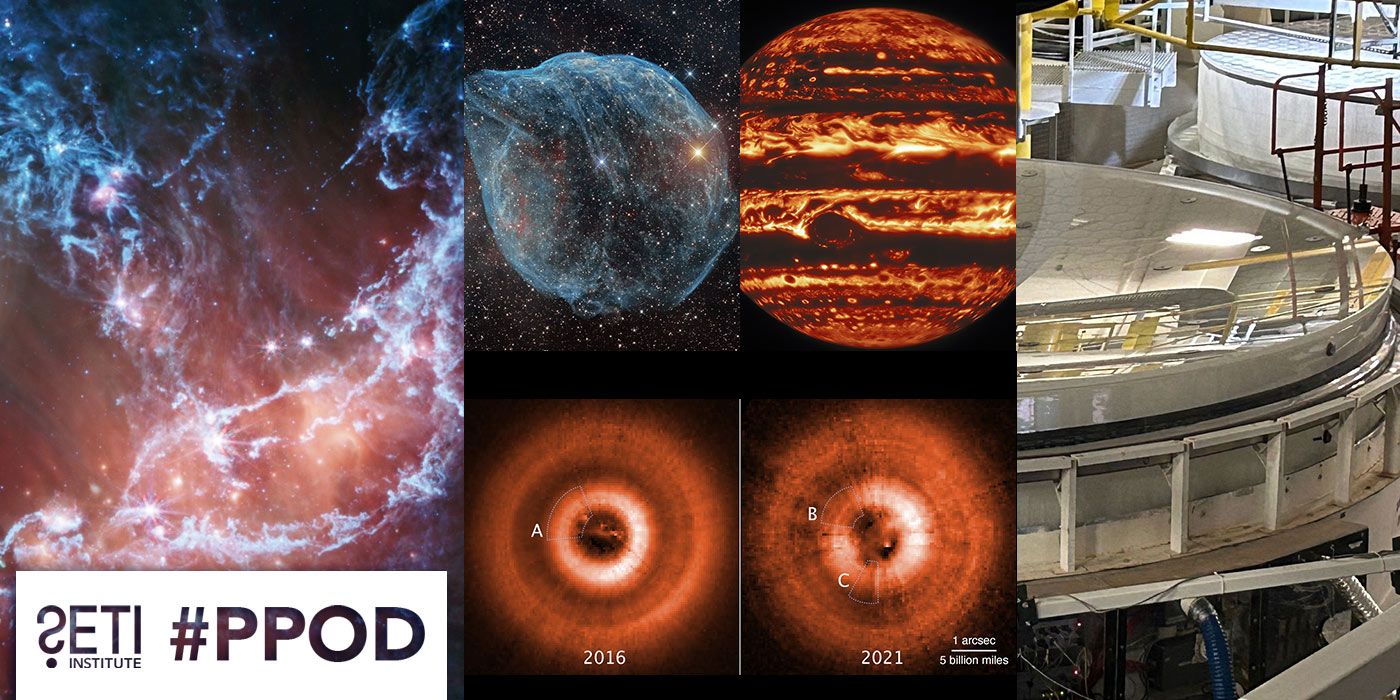
Planetary Picture of the Day
Week of October 9, 2023
An evolving planetary disk, an evolving star, and an 'evolving' telescope mirror.
Monday, October 9, 2023

TW Hydrae Disk
Comparison images from the Hubble Space Telescope, taken several years apart, have uncovered two eerie shadows moving counterclockwise across a gas-and-dust disk encircling the young star TW Hydrae.
The disks are tilted face-on to Earth and so give astronomers a bird's-eye view of what's happening around the star. The left image, taken in 2016, shows just one shadow [A] at the 11:00 o'clock position. This shadow is cast by an inner disk that is slightly inclined to the outer disk and so blocks starlight. The picture on the left shows a second shadow that emerged from yet another nested disk [C] at the 7:00 o’clock position, as photographed in 2021. The original inner disk is marked [B] in this later view. The shadows rotate around the star at different rates like the hands on a clock. They are evidence for two unseen planets that have pulled dust into their orbits. This makes them slightly inclined to each other.
This is a visible-light photo taken with the Space Telescope Imaging Spectrograph. Artificial color, to enhance details, has been added.
Tuesday, October 10, 2023

The Dolphin-Head Nebula
Blown by fast winds from a hot, massive star, this cosmic bubble is huge. Cataloged as Sharpless 2-308 it lies some 5,000 light-years away toward the constellation of the Big Dog (Canis Major) and covers slightly more of the sky than a Full Moon. That corresponds to a diameter of 60 light-years at its estimated distance.
The massive star that created the bubble, a Wolf-Rayet star, is the bright one near the center of the nebula. Wolf-Rayet stars have over 20 times the mass of the Sun and are thought to be in a brief, pre-supernova phase of massive star evolution. Fast winds from this Wolf-Rayet star create a bubble-shaped nebula as they sweep up slower-moving material from an earlier phase of evolution. The windblown nebula has an age of about 70,000 years.
Wednesday, October 11, 2023

Infrared View of Jupiter
This infrared view of Jupiter was created from data captured on 11 January 2017 with the Near-InfraRed Imager (NIRI) instrument at Gemini North in Hawaiʻi, the northern member of the international Gemini Observatory, a Program of NSF’s NOIRLab. It is actually a mosaic of individual frames that were combined to produce a global portrait of the planet.
In the image, warmer areas appear bright, including four large hot spots that appear in a row just north of the equator. South of the equator, the oval-shaped and cloud-covered Great Red Spot appears dark.
Thursday, October 12, 2023

Caption: The Giant Magellan Telescope
Giant Magellan Mirror
Here is one of the mirrors of the Giant Magellan Telescope being readied at the Richard F. Caris Mirror Lab in Tucson, AZ! Using seven of the world’s largest mirrors, the Giant Magellan Telescope will have 50 million times the light-gathering power of the human eye and will be up to 200 times more powerful than today’s best telescopes! The Giant Magellan Telescope will produce the highest possible image resolution of the Universe over the widest field of view with only two light-collecting surfaces, making it the most optically proficient of all telescopes in the 30-meter-class. Note the honeycomb structure!
The Giant Magellan Telescope is the largest Gregorian optical-infrared telescope in history. It will use seven of the world’s largest mirrors to see farther into deep space than ever before. Its unique design will produce the highest possible resolution of the Universe over the widest field of view. This extraordinary image clarity will enable scientists around the globe to obtain new clues to the fundamental nature and evolution of the Universe — from searching for signs of life on distant exoplanets to investigating the cosmic origins of chemical elements.
The telescope will be based at the Observatory in Chile’s Atacama Desert, one of the best locations on Earth to view the heavens. A massive 22-story smart home shelters the Giant Magellan Telescope from harsh weather and extreme earthquakes that the Chilean Atacama Desert is famous for. The 4,800 metric tons enclosure can complete a full rotation in nearly 3 minutes. It’s designed to disappear at night, equalize shifting airflows and temperatures, and reveal the telescope for unobstructed observations as the world's largest mirrors track celestial targets moving across the sky.
Friday, October 13, 2023

Ethereal NGC 346
This new infrared image of NGC 346 from NASA’s James Webb Space Telescope’s Mid-Infrared Instrument (MIRI) traces emission from cool gas and dust. In this image blue represents silicates and sooty chemical molecules known as polycyclic aromatic hydrocarbons, or PAHs. More diffuse red emission shines from warm dust heated by the brightest and most massive stars in the heart of the region. Bright patches and filaments mark areas with abundant numbers of protostars. This image includes 7.7-micron light shown in blue, 10 microns in cyan, 11.3 microns in green, 15 microns in yellow, and 21 microns in red (770W, 1000W, 1130W, 1500W, and 2100W filters, respectively).





